|

On eBay Now...
WW1 42nd Rainbow Division 165th Named Militaria Grouping Amazing Archive of Item For Sale
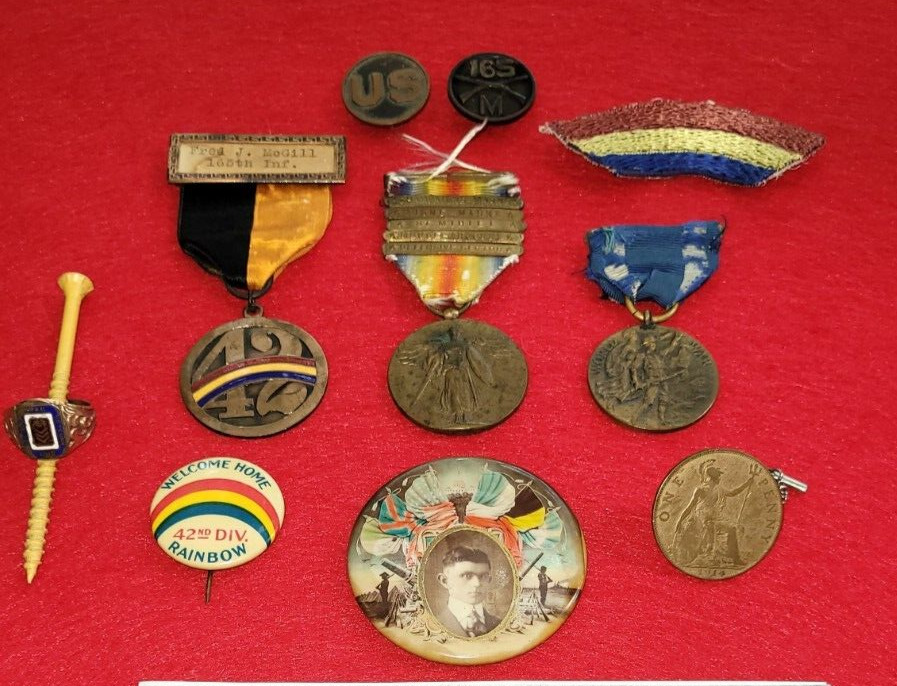
When you click on links to various merchants on this site and make a purchase, this can result in this site earning a commission. Affiliate programs and affiliations include, but are not limited to, the eBay Partner Network.

WW1 42nd Rainbow Division 165th Named Militaria Grouping Amazing Archive of Item:
$425.00
Amazing Grouping of WW1 Rainbow 42nd Division 165th InfantryMedals, Pinback , Rainbow Division Patch, 165th M Collar Brass, Tie Tack, Pocket Mirror, Early Reunion Medal, (AEF) American Expeditionary Force Ring Wonderful ID\'d Grouping To PFC then corporal Frederick J. MCgill
Note I will be setting up with my brother at the upcoming Militaria show In Doswell Va near Richmond this coming weekend July 15th and 16th. If you are coming to the show drop me a line. Always happy to meet fellow enthusiasts.
This afternoon I am very excited to bring to you a really cool grouping of material Identified to one Corporal Frederick J. Mcgill who serverd honorably in the highly acclaimed and historically significant 42nd Rainbow Division 165th Infantry Regiment formerly the 69th NY National Guard affectionately known as the fighting 69th about whom a movie staring James Cagney and Pat Obrien was made.The grouping contains a wonderful mix of material. There are eleven Items in total and I shall list them one at a time and describe them as best I can. Please see photos as they are an important supplement to my description.!) Beautifull WW! victory medal with 5 battle clasps { Champaine Marne, Aisne Marne, St Mihiel, Meuse Argonne, Defense sector} Note the 42nd is recognized as fighting in all those battles which matches up with bars. Medal is showing wear and ribbon is attached but exhibiting some separation from top clasp.
2+3) Mcgills Collar device \"US and 165th Infantry Company M. Very nice condition with screrwbacks present
4) His What I believe to be \"in country made\" Uniform 42nd Division Rainbow patch.
5) World War One NY State Service Medal with ribbon. Medal worn and ribbon shows significant wear.
6) Strikingly hansome 42nd Rainbow Division 1929 11th reunion Convention badge with black and gold ribbon and Insert with \"Fred J Mcgill\" in the window of the badge.(Pinback is present but I do not see a clasp and I am not sure if it ever had one) Maker Marked \"Greenduck Co. Chicago\"
7) Beautiful condition \"Welcome Home 42nd Division Rainbow\" pinback button. Colors are still vibrant after 100+ years.
8) An absolutely wonderful Photo Pocket mirror with what I am assuming is a photo of Mcgill in a suit and tie and is surrounded on the face of it by Flags of the allies in ww1 and flanked by cannons and soldiers standing their post. also at the top of the image the Capital building can be seen off in the distance. Wonderful imagery and gives us the ability to put a face to the name and see the soldier himself (Note mirror itself has some imperfections.9) A very nice Enameled (AEF) American Expeditionary Force Ring. Inside the ring there is a hallmark reading \"12K Gold Shell\" The ring has a rectangular face on it with the words \"World war veteran 1918\" around the perimiter and \"AEF with 3 gold chevrons. Ring is in nice antique condition but does have some loss to enameling and is slightly misshapen.
10) British 1914 Penny \"Trench Art\" that has been converted to a tie Tack
11) Facsimile copy of his militaryrecords with significant dates etc.I am sure you will agree this is a wonderful grouping of original material and would make a great addition to a Rainbow Division collector specifically or general militaria collector as well.
Note on Shipping charges, It reflects Cost of USPS shipping and Insurance on this Great grouping. Any Overage will be gladly refunded. I will be sending the grouping \"Signature required and Insured for every ones protection. I have no intention of making a profit on the shipping. I just want to cover the actual USPS charges. Thanks for your understandingBelow please find a ton of great information on the Rainbow division through WW1
Below are a couple letters from Mcgill to his sweetheart from overseas during the war. I found them when googling his name. They are held in a large collection of doughboy letters home in a Michigan library.It really helps to put the grouping in context to a real person in a critical time in our nations history. Enjoy!
Fred McGill, September 4, 1917. Camp Mills, New York.4 “Last night about (35) thirty five fellows that were absent came in about ten o’clock and they were singing ‘Hail! Hail! the gangs all here.’ and the Captain walked out and told them they were under arrest and you could see there faces drop and then they went down the Co. street singing at the top of there lungs ‘When All the Sunshine turns to Gloom.’ Gee it was funny one of the bunch was from our tent and he kept us awake half the night telling about the good time he had in the City.”
2)Fred McGill, May 20, 1918. Somewhere in France. “Well Girlie we expect to be very busy soldiers in the next month or so as we expect to move to another front and I believe it will be a busy one you have heard that we dont get much sleep up near the front line...it is some sensation having those big shells singing over your head day and night and the first time gee what a job keeping your knees from knocking together but it dont take long to get over the first shock.”3)66. McGill, Frederick Collection, 1917-1919The above taken from original letters home from McGill. Letters held in the William M. Clements library in Ann Arbor Michigan.
4 Frederick John McGill (1894-1984) was born in Sea Cliff, New York. He served in the 165th Infantry Regiment, which saw heavy front-line service. After returning home in 1919, he married his longtime sweetheart, Louise A. Rochat (1895-1973). All of McGill’s quotations used in this pamphlet come from his correspondence with Louise in the Frederick McGill Collection, 1917-1919, DNDC
Info on the 42ndThe42nd Infantry Division(42ID) (\"Rainbow\"[1]) is adivisionof the United StatesArmy National Guard. The 42nd Infantry Division has served inWorld War I,World War IIand theGlobal War on Terrorism(GWOT). The division is currently headquartered at the Glenmore Road Armory inTroy, New York. The division headquarters is a unit of theNew York Army National Guard. The division currently includes Army National Guard units from fourteen different states, including Connecticut, Maine, Maryland, Massachusetts, New Hampshire, New Jersey, New York, Rhode Island, and Vermont. As of 2007, 67 percent of 42ID soldiers are located in New York and New Jersey.[2] Rainbow Division[edit]When the United Statesdeclared war on Germany in April 1917, and so officially enteringWorld War I, it federalized the National Guard and formed their units into divisions to quickly build up an Army. In addition,Douglas MacArthur, then amajor, suggested toWilliam Abram Mann, the head of theMilitia Bureau, that he form another division from the units of several states that were not assigned to divisions. Secretary of WarNewton D. Bakerapproved the proposal, and recalled MacArthur saying that such an organization would \"stretch over the whole country like a rainbow.\"[3]On 1 August 1917, theWar Departmentdirected the formation of a composite National Guard division, comprising units from 26 states and theDistrict of Columbia. As a result, the 42nd Division came to be known as the \"Rainbow Division\". The name stuck, and MacArthur was promoted tocoloneland became the division\'s chief of staff, with Mann as its commander.[4] Rainbow unit insignia[edit]Original design of 42nd Infantry Division \"Rainbow\" patch, showing half arc. The patch was later modified to a quarter arc.Another version of the original design of 42nd Infantry Division \"Rainbow\" patch, showing half arc.WW I colors unfurled for first time in France. Note half arc rainbow in design.The 42nd Division adopted ashoulder patchand distinctive unit insignia acknowledging the nickname.[5][6]The original version of the patch symbolized a half arc rainbow and contained thin bands in multiple colors.[7][8][9]During the latter part of World War I and post war occupation duty in Germany, the patch was changed to a quarter arc.[10]According to the division\'s official history, Colonel William N. Hughes Jr., who had succeeded MacArthur as chief of staff, was credited with modifying the design to a quarter arc in an attempt to standardize it.[10]Division lore includes the story that division commanderCharles T. Menoherapproved the patch after observing a rainbow shortly before a battle, deciding this was a favorable omen.[10]According to World War I veterans of the 42nd Division, soldiers removed half the original symbol to memorialize the half of the division\'s soldiers who had been killed or wounded during the war.[7][11]They also reduced the number of colors to just red, gold and blue bordered in green, to standardize the design and make the patch easier to reproduce.[9][10] Description: The 4th quadrant of a rainbow with three bands of color: red, gold and blue, each 3/8-inch (.95cm) in width, outer radius 2 inches (5.08cm); all within a 1/8-inch (.32cm) Army green border.[5] Background: Theshoulder sleeve insigniawas originally authorized by telegram on 29 October 1918.[5]It was officially authorized for wear on 27 May 1922.[5]It was reauthorized for wear when the division was reactivated for World War II.[5]On 8 September 1947, it was authorized for the post-World War II 42nd Infantry Division when it was reactivated as a National Guard unit.[5] World War I[edit]Men of Company D, 165th Infantry Regiment, 42nd Division, on hike fromBénaménil, France, to a rest camp atChenevières, March 1, 1918.Memorial in Fère-en-Tardenois (France).The 42nd Division was assembled in August 1917 atCamp Mills,New York, four months after theAmerican entryintoWorld War I. The 42nd arrived overseas to theWestern FrontofBelgiumand France in November 1917, one of the firstdivisionsof theAmerican Expeditionary Forces(AEF) to do so, under the command ofMajor GeneralWilliam A. Mannalthough he was soon to be replaced by Major GeneralCharles T. Menoher, who remained in this position for the rest of the war.ColonelDouglas MacArthurwas the division\'s chief of staff until he later went on to command the 84th Brigade of the division.[12]The AEF was commanded byGeneralJohn Joseph Pershing. After initially landing atSt. Nazaire(France), the 42nd was temporarily located atVaucouleurs,Lorraine(France), from 7 November – 7 December 1917, to preliminarily train before transferring to anothertrainingarea betweenLafaucheandRimaucourt.[13]The day after Christmas, the 42nd, along with otherdivisionsit had now linked up with, departed for anothertrainingarea been attached to the 42nd atLafauche,Rimaucourt, andRolampontas instructors intrench warfarewho \"...seemed, from Menoher and MacArthur\'s view, to think more highly of the Rainbow\'s performance than didPershingand hisChaumontstaff\".[15] \"On February 13, 1918, the day that the [3-day]inspection[by General Pershing\'sheadquarter\'sstaff fromChaumont] was completed,Pershingorderedthe 42nd division to move to theLunévillesector of southernLorrainefor a month\'strainingat thefrontwith theFrench VII Corps\".[16]\"Rainbow division entrained for theLunévillesector on February 16, 1918, and it was joined by the 67th Field Artillery Brigade shortly thereafter.[17]Rainbow\'s soldiers were distributed over the entire sixteen-milefrontof the sector, fromLunévillepastSt. ClémenttoBaccarat.[18]As far as administration, supply, and discipline were concerned, thedivisionwas part ofMGHunter Liggett\'sI Corps, A.E.F., but forcombatandtrainingpurposes it was underMajor GeneralGeorges de Bazelaire, of the French VII Army Corps, with each of the 42nd\'s Regiments assigned to one of the FrenchDivisionsholding the sector.[18]EachAmericanbattalionserved one week at a time on thefrontline, then spent the next week on the secondline of defense, and the third week inreserve[18]AcuteShortagesof some types of equipment still existed, as evidenced, for example, byMenoher\'sorderthattroopsof abattalionleaving thefront linewere to yield theirPistolsto the men of therelievingbattalion\".[19] On 16 June 1918, General Pershing ordered the 42nd to entrain to \"theChampagneregion east ofRheims(a sector comparatively more active thanBaccarat) to be assigned toGeneralHenri Gouraud\'sFourth Army\"; relinquishing the currentBaccaratsector \"to the relievingAmerican77thand French61stdivisions\".[20] During 1918, Rainbowdivision, specifically with the 67th Field Artillery\'s \"1650 projectiles\" in the Bois des Chiens, engaged German forces with and experienced bombardment by German forces with deadly, poison-gasBombardments, specifically with German75-mm.and105-mm.shellsfilled withpaliteandyperite(also known as Mustard gas).[21]The 42nd took part in four major operations: theChampagne-Marne, theAisne-Marne, theBattle of Saint-Mihiel, and theMeuse-Argonne Offensive. In total, it saw 264 days of combat. Soldiers of the 167th Infantry Regiment man positions near St. Benoit, on the Meuse River, during the St. Mihiel offensive, September 1918.- Casualties: total 14,683 (KIA – 2,058; WIA – 12,625).
- Commanders:MG W. A. Mann(5 September 1917), Brig. Gen.Charles T. Menoher(19 December 1917), Maj. Gen.Charles D. Rhodes, (7 November 1918), Brig. Gen.Douglas MacArthur(10 November 1918), Maj. Gen.C. A. F. Flagler(22 November 1918), Brig. Gen.George G. Gatley(28 March 1919), Maj. Gen.George Windle Read(10 April 1919 toDivision\'sdeactivation on 9 May 1919).
The 42ndDivisionwas demobilized in May 1919 atCamp Upton, New York,Camp Grant,Illinois,Camp Dix,New Jersey, andCamp Dodge,Iowa. Order of battle[edit]Square Division example: 1940 US Infantry Division. On the far left can be seen two Brigades of two Regiments each- Headquarters, 42ndDivision(futureGeneral of the Army, then Colonel Douglas MacArthur, served as the chief of staff of the 42nd Division)
- 83rd Infantry Brigade
- 165th Infantry Regiment(formerly 69th Infantry, New York National Guard)
- Notable members:MajorWilliam \"Wild Bill\" Donovan,ChaplainFrancis P. Duffy,SergeantJoyce Kilmer
- Significant events:Rouge Bouquet
- 166th Infantry Regiment(formerly 4th Infantry, Ohio National Guard)
- 150th Machine Gun Battalion (formerly Companies E, F, and G, 2nd Infantry, Wisconsin National Guard)
- 84th Infantry Brigade (this was the brigade that Brigadier General Douglas MacArthur commanded from July 1918 to November 1918)
- 167th Infantry Regiment(formerly 4th Infantry, Alabama National Guard)
- 168th Infantry Regiment(formerly 3rd Infantry, Iowa National Guard)
- 151st Machine Gun Battalion (formerly Companies B, C, and F, 2nd Infantry, Georgia National Guard)
- 67th Field Artillery Brigade
- 149th Field Artillery Regiment (75mm) (formerly 1st Field Artillery, Illinois National Guard)
- 150th Field Artillery Regiment(155mm) (formerly 1st Field Artillery, Indiana National Guard)
- 151st Field Artillery Regiment (75mm) (formerly 1st Field Artillery, Minnesota National Guard)
- 117th Trench Mortar Battery (formerly 3rd and 4th Companies, Coast Artillery, Maryland National Guard)
- 149th Machine Gun Battalion (formerly 3rd Battalion, 4th Infantry, Pennsylvania National Guard)
- 117th Engineer Regiment (formerly Separate Battalions, Engineers, California and South Carolina National Guards)
- 117th Field Signal Battalion (formerly 1st Battalion, Signal Corps, Missouri National Guard)
- Headquarters Troop, 42nd Division (formerly 1st Separate Troop, Cavalry, Louisiana National Guard)
- 117th Train Headquarters and Military Police (formerly 1st and 2nd Companies, Coast Artillery, Virginia National Guard)
- 117th Ammunition Train (formerly 1st Ammunition Train, Kansas National Guard)
- 117th Supply Train (formerly Supply Train, Texas National Guard)
- 117th Engineer Train (formerly Engineer Train, North Carolina National Guard)
- 117th Sanitary Train (165th–168th Ambulance Companies and Field Hospitals)
- 165th Ambulance Company (formerly 1st Ambulance Company, Michigan National Guard)
- 165th Field Hospital (formerly 1st Field Hospital, Washington, D.C. National Guard)
- 166th Ambulance Company (formerly 1st Ambulance Company, New Jersey National Guard)
- 166th Field Hospital (formerly 1st Field Hospital, Nebraska National Guard)
- 167th Ambulance Company (formerly 1st Ambulance Company, Tennessee National Guard)
- 167th Field Hospital (formerly 1st Field Hospital, Oregon National Guard)
- 168th Ambulance Company (formerly 1st Ambulance Company, Oklahoma National Guard)
- 168th Field Hospital (formerly 1st Field Hospital, Colorado National period[edit]
As the 42nd was a composite division, it was not contemplated for reorganization after World War I, and all of its former elements were assigned to other National Guard divisions or remained demobilized. Thanks for looking and
SOELONG

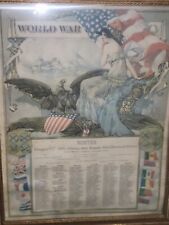
Roster WW1 Company "C" 168th Infrantry, 84th Brigade 42nd (Rainbow) Division $175.00
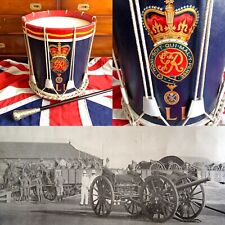
Amazing WW1 42nd Brigade, Royal Field Artillery “George V” Regimental Side Drum. $753.78
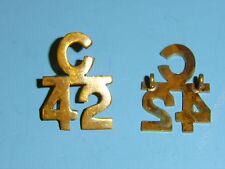
a0134p WW 1 Canadian Collar Emblems for 42nd Highlanders C42 pair C10A13 $22.00

WW1 US Army Rainbow 42nd Division 166th Regiment Large Photo Framed NEW PRICE $175.00
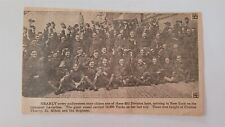
42nd Division Soldiers USS Leviathan Chateau Thierry Argonne 1919 WW1 Picture $24.99

Chicago Illinois Reilly's Bucks 33rd 42nd 89th 90th Division 1919 WW1 Picture $24.99
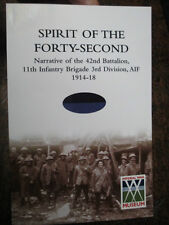
42nd Australian WW1 Bn ' SPIRIT OF THE FORTY- SECOND 42 Battalion AIF 1914-18 $30.65
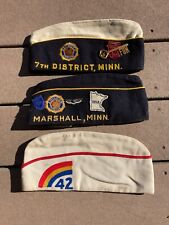
Lot of 3 American Legion Side Flat Caps Hats 42nd Infantry Division WW1 $89.99
|